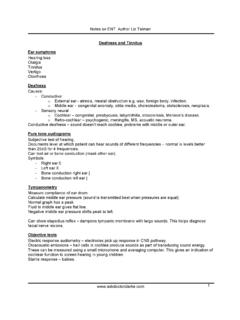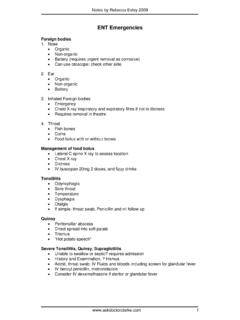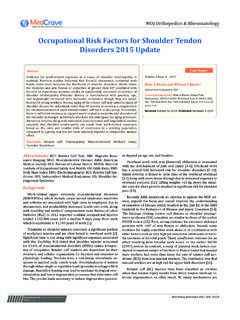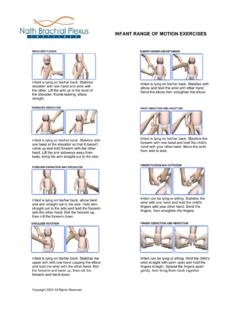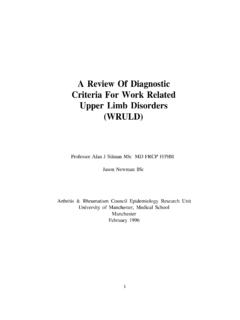Transcription of Musculoskeletal (MSK) Problems: Principles of …
1 Notes on Rheumatology Author: Liz Tatman Musculoskeletal (MSK) Problems: Principles of Management MSK symptoms Pain site, radiation (get radiation distally, more common with more proximal joints shoulder and knee), quality (shooting with nerve entrapment). Onset. With usage (mechanical), at rest (inflammatory). or at night (if no relation to movement concern about bony mets). Bony pain well localised, doesn't radiate, progressive, night predominant, not related to movement, due to fractures, neoplasia, Paget's disease, osteomalacia, osteomyelitis, osteonecrosis. Referred pain poorly localised, diffuse, improved by rubbing. Can get neuropathic pain sometime after injury. Stress pain in tight pack positions, if in all directions suggests synovitis. Stiffness prolonged early morning and inactivity imply inflammatory cause.
2 Swelling and deformity. Instability Locking sudden inability to move joint, usually painful but transient, post unlocking discomfort. Affects hinge joints (knee, elbow, TMJ). Mechanical problem synovium, cartilage, split meniscus. Loss of function, disability and handicap. Systemic illness night sweats, malaise, fatigue, weight loss suggest inflammatory process. Sleep disturbance. Red flags: progressive, well localised progressive night-predominant pain (mets), red hot joint (sepsis), sequential joint involvement (spreading sepsis). History need to determine if traumatic or non-traumatic, ask about dominant hand. Trauma time, place, mechanism (twist, blow, crush), magnitude of force, direction of force, first aid, immediate symptoms and progression, previous injuries.
3 Non-trauma rule out (RESTIT) Referred pain, Embolus, Sepsis, Tumour, Ischaemia, Thrombosis. Systems enquiry for non MSK causes, associated features, drug toxicity, pre-op assessment and involvement of other organs. Especially general malaise (anaemia), hot and shivery (infection), skin (rashes, psoriasis, Raynaud's), eyes (iritis, scleritis). MSK signs Attitude hold joints in loose-pack position so capsule minimally stretched and can accommodate oedema. Deformity correctable or fixed, can be due to soft tissue (scarring, swelling or overgrowth), bone or joints. Malalignment, varus (distal part medially), valgus (distal part laterally), fixed flexion, subluxation (slip from normal alignment but still in contact), dislocation. Skin changes red with sepsis, crystals, also rheumatism, reactive arthropathy.
4 Psoriasis. Muscle bulk and strength. Swelling can be fluid (effusion, haemarthrosis if very quick after trauma), soft tissue or bone. If moves with tendons (tuck sign) implies tenosynovitis. Nodules rheumatoid nodules, gout tophi, hyperlipidaemia xanthomata (also lupus, rheumatic fever, histiocytosis, polyarteritis nodosa, sarcoidosis). Signs of effusion small bulge sign, moderate - , large balloon sign. Tenderness. Range of movement restricted, hypermobile. Stress pain is increasing pain towards extremes of movements if universal then synovitis, if selective then localised lesion in or around joint. May be most painful in tight pack position capsule at tightest so can't accommodate pressure rise. Loss of movement may due to loss of muscle power, damage to joint, reflex inhibition of muscle, protective muscle spasm.
5 Crepitus fine is due to tendon sheath or bursa, coarse conducts through bone and can be heard. Warmth. Stability. Dr R Clarke 1. Notes on Rheumatology Author: Liz Tatman Differentiating arthropathy and periarticular lesion: Arthropathy joint line tenderness, active and passive movement equally tender and restricted, capsular swelling, diffuse warmth, coarse crepitus, pain in several directions of movement. Periarticular lesion periarticular tenderness, active movement more painful and restricted than passive, pain with resisted active movement, localised swelling and warmth, fine crepitus, usually pain only with one direction of use. Divide into single regional (injury, overuse) or multiple regional (fibromyalgia). Differentiating synovitis and inflammation from mechanical joint damage: Synovitis lots of stiffness, warmth, stress pain, soft tissue swelling, large effusion.
6 No crepitus, deformity or instability. Joint damage no or minimal stiffness, warmth, stress pain, soft tissue swelling and effusion. Crepitus, deformity and instability. Investigations Aim to support diagnosis or monitor disease. Screening blood tests FBC, U&Es (renal involvement, drugs). Inflammatory markers ESR - normal 0-10 in males, 0-20 in females but increases with age. CRP quickest to change. Synovial fluid analysis Indications to diagnose acute bacterial sepsis and crystal associated disease if acute monoarthritis. Both of these are curable. To confirm a joint is not infected and differentiate inflammatory (raised cell count) and non-inflammatory effusions. If suspect sepsis then need to do gram stain and culture. If suspect crystals do compensated polarised light microscopy.
7 Normal synovial fluid low volume, low cell count, clear, straw coloured, high viscosity, GAGs. Synovial fluid in inflammation becomes opaque (neutrophils), becomes less viscous, increased volume. Blood stained traumatic aspiration (non-uniform), haemarthoris (uniform due to trauma, severe inflammation, bleeding diathesis, rare tumours, subchondral fracture if lipid layer on surface). Pus (pyoarthrosis) very high concentration of neutrophils due to sepsis or crystals. Synovial biopsy To diagnose chronic monoarthritis. Can see chronic infection TB, foreign body, sarcoidosis, amyloid. Anaemia Chronic disease normochromic, normocytic. Occult bleeding NSAID treatment, increased TIBC. Bone marrow suppression methotrexate. Haemolytic SLE. Remember ferritin is an acute phase protein so increased if inflammation.
8 Autoantibodies Rheumatoid factor: Positive in 70% RA. Usually higher titres with more severe disease, nodules, vasculitis and lung in lupus, scleroderma, other CTDs, chronic infection, viruses (rubella, CMV), parasites, health people. Dr R Clarke 2. Notes on Rheumatology Author: Liz Tatman Antinuclear factor: Positive in 100% SLE good screening test but poor specificity. Also in RA, Felty's, scleroderma, autoimmune thyroid disease, liver disease, juvenile chronic arthritis, normal subjects. Includes various subgroups. Anti double-stranded DNA is more specific for lupus and a poor prognostic factor. Anti-histone with drug induced lupus. Also Ro, La, Sm, Scl 70 and centromere. ANCA: Antineutrophil cytoplasmic antibody. cANCA specific to Wegener's. pANCA less specific, other vasculitides.
9 Antiphospholipid: In antiphospholipid syndrome. CPK. Elevated with inflammatory myopathy, vasculitis, muscular dystrophy, MND, alcohol, drugs, trauma, strenuous exercise, MI, hypothyroidism, metabolic myopathy. Imaging Xrays bone, fractures. CT bony structures, complex bones ankle. MRI discs in spine, cord compression, knee menisci and ligaments. Isotope bone scanning show metastatic bone disease, not myeloma. DEXA bone density. Bone biopsy to diagnose osteomalacia, renal osteodystrophy, osteoporosis in young pts. Arthroscopy Especially for knee. Evaluate mechanical problems menisci, take synovial biopsy (esp if concerned about TB), diagnose septic arthritis. Nerve conduction studies Have orthodromic (same way as nerve) and antidromic (opposite way) conduction. Give stimulus and look for when it reaches probe.
10 Do from proximal to carpal tunnel and distal to carpal tunnel. Look for drop in velocity as go through carpal tunnel/cubital tunnel etc. Need to lose most of fibres before slowing apparent. Management To educate patient, treat pain, restore function and modify disease process. Specific medical or surgical treatment - to relieve pain, correct deformities, prevent arthritis, allow mobilisation. Pain relief and symptoms control - need to do this for humane reasons and also to allow rehabilitation and movement. Rehabilitation. Types of surgery arthroplasty (new joint), excision arthroplasty (remove all or part of joint), arthrodesis (stiffening of joint), arthrotomy (opening joints, usually for access for arthroscopy), osteotomy (cutting bone), fixation of bone, soft tissue release (tight tendons, soft tissue contracture, decompression of nerve or muscle), synovectomy (may help with pain relief), tendon transfers or repairs, amputation.
